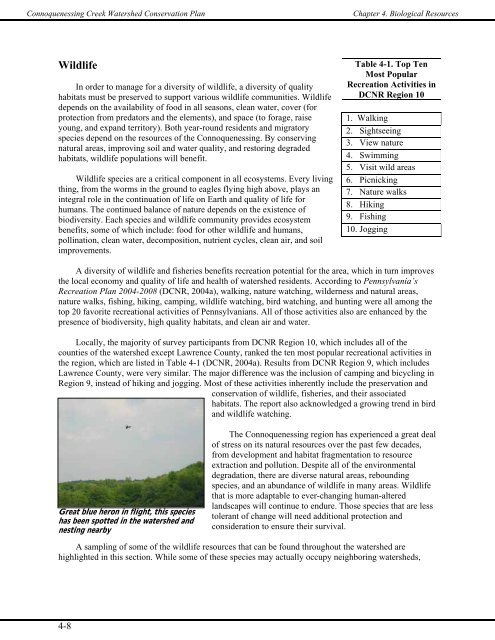CHAPTER 4 - Western Pennsylvania Conservancy
CHAPTER 4 - Western Pennsylvania Conservancy
CHAPTER 4 - Western Pennsylvania Conservancy
You also want an ePaper? Increase the reach of your titles
YUMPU automatically turns print PDFs into web optimized ePapers that Google loves.
Connoquenessing Creek Watershed Conservation Plan<br />
Chapter 4. Biological Resources<br />
Wildlife<br />
In order to manage for a diversity of wildlife, a diversity of quality<br />
habitats must be preserved to support various wildlife communities. Wildlife<br />
depends on the availability of food in all seasons, clean water, cover (for<br />
protection from predators and the elements), and space (to forage, raise<br />
young, and expand territory). Both year-round residents and migratory<br />
species depend on the resources of the Connoquenessing. By conserving<br />
natural areas, improving soil and water quality, and restoring degraded<br />
habitats, wildlife populations will benefit.<br />
Wildlife species are a critical component in all ecosystems. Every living<br />
thing, from the worms in the ground to eagles flying high above, plays an<br />
integral role in the continuation of life on Earth and quality of life for<br />
humans. The continued balance of nature depends on the existence of<br />
biodiversity. Each species and wildlife community provides ecosystem<br />
benefits, some of which include: food for other wildlife and humans,<br />
pollination, clean water, decomposition, nutrient cycles, clean air, and soil<br />
improvements.<br />
Table 4-1. Top Ten<br />
Most Popular<br />
Recreation Activities in<br />
DCNR Region 10<br />
1. Walking<br />
2. Sightseeing<br />
3. View nature<br />
4. Swimming<br />
5. Visit wild areas<br />
6. Picnicking<br />
7. Nature walks<br />
8. Hiking<br />
9. Fishing<br />
10. Jogging<br />
A diversity of wildlife and fisheries benefits recreation potential for the area, which in turn improves<br />
the local economy and quality of life and health of watershed residents. According to <strong>Pennsylvania</strong>’s<br />
Recreation Plan 2004-2008 (DCNR, 2004a), walking, nature watching, wilderness and natural areas,<br />
nature walks, fishing, hiking, camping, wildlife watching, bird watching, and hunting were all among the<br />
top 20 favorite recreational activities of <strong>Pennsylvania</strong>ns. All of those activities also are enhanced by the<br />
presence of biodiversity, high quality habitats, and clean air and water.<br />
Locally, the majority of survey participants from DCNR Region 10, which includes all of the<br />
counties of the watershed except Lawrence County, ranked the ten most popular recreational activities in<br />
the region, which are listed in Table 4-1 (DCNR, 2004a). Results from DCNR Region 9, which includes<br />
Lawrence County, were very similar. The major difference was the inclusion of camping and bicycling in<br />
Region 9, instead of hiking and jogging. Most of these activities inherently include the preservation and<br />
conservation of wildlife, fisheries, and their associated<br />
habitats. The report also acknowledged a growing trend in bird<br />
and wildlife watching.<br />
Great blue heron in flight, this species<br />
has been spotted in the watershed and<br />
nesting nearby<br />
The Connoquenessing region has experienced a great deal<br />
of stress on its natural resources over the past few decades,<br />
from development and habitat fragmentation to resource<br />
extraction and pollution. Despite all of the environmental<br />
degradation, there are diverse natural areas, rebounding<br />
species, and an abundance of wildlife in many areas. Wildlife<br />
that is more adaptable to ever-changing human-altered<br />
landscapes will continue to endure. Those species that are less<br />
tolerant of change will need additional protection and<br />
consideration to ensure their survival.<br />
A sampling of some of the wildlife resources that can be found throughout the watershed are<br />
highlighted in this section. While some of these species may actually occupy neighboring watersheds,<br />
4-8














